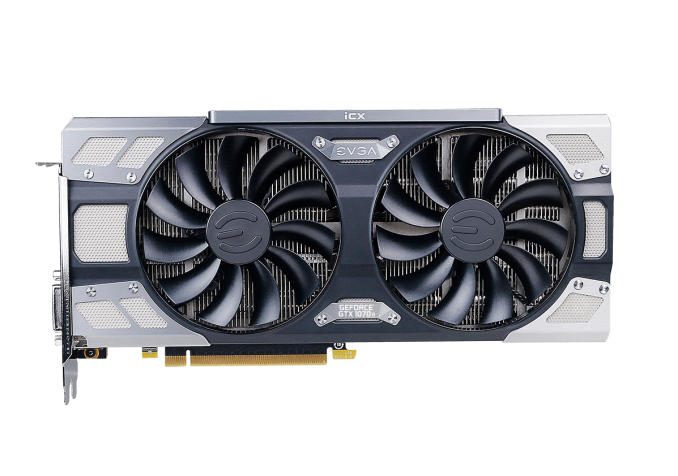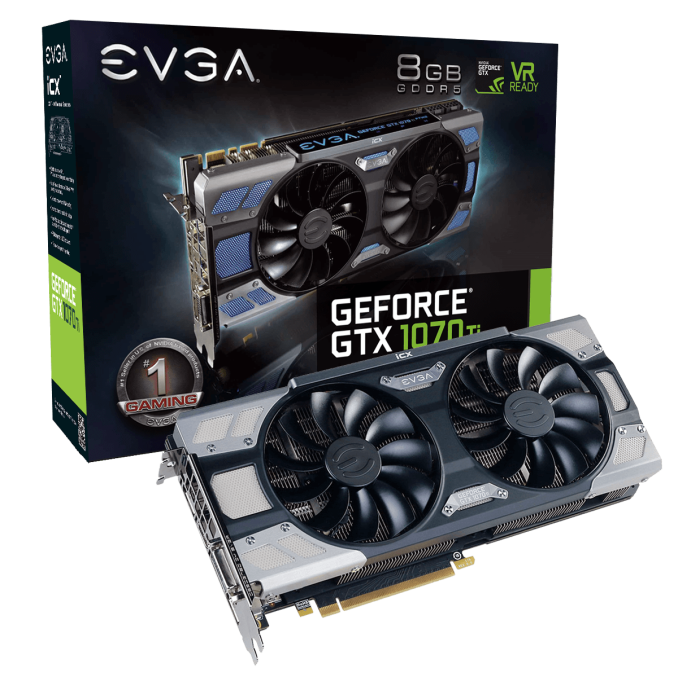The EVGA GeForce GTX 1070 Ti FTW2 Review: iCX Brings the Lights and Sensors
by Nate Oh on January 31, 2018 9:00 AM EST- Posted in
- GPUs
- EVGA
- GeForce
- NVIDIA
- GTX 1070 Ti

A few months ago, NVIDIA released the GeForce GTX 1070 Ti series with their Founders Edition card, accompanied by a number of partner boards. Targeting the competing Radeon RX Vega 56, the launch put the GTX 1070 Ti right between the GeForce GTX 1080 and 1070 in terms of price and performance, filling a gap that was not particularly wide in the first place. That level of performance was achieved through a new 19 SM configuration of GP104 with a 180W TDP and 1607MHz core clock over the GeForce GTX 1070 with its 15 SMs, 150W TDP, and 1506MHz core clock.
And in consideration of that, all partner GTX 1070 Ti cards adhere to the reference 1607MHz core and 1683MHz boost clocks. In this way, the model could exist in the $450 – $500 MSRP window without significantly cannibalizing sales of the neighboring GTX 1080 and 1070. So for EVGA, they rolled out four GeForce GTX 1070 Ti models at launch, all featuring the same clocks. But as NVIDIA did with the Founders Edition, EVGA is also pushing overclocking as one of the selling points, leaning on their Precision XOC utility and its GTX 1070 Ti specific overclock autoscan.
Going straight to the higher-end with the FTW model, today we are taking a look at the EVGA GeForce GTX 1070 Ti FTW2, equipped with the iCX temperature sensor and cooling system.
| GeForce GTX 1070 Ti Specification Comparison | |||||
| EVGA GTX 1070 Ti FTW2 |
NVIDIA GTX 1070 Ti Founders Edition |
EVGA GTX 1070 Ti SC Black Ed. |
|||
| CUDA Cores | 2432 | 2432 | 2432 | ||
| Texture Units | 152 | 152 | 152 | ||
| ROPs | 64 | 64 | 64 | ||
| Core Clock | 1607+MHz | 1607MHz | 1607+MHz | ||
| Boost Clock | 1683+MHz | 1683MHz | 1683+MHz | ||
| Memory Clock | 8Gbps GDDR5 | 8Gbps GDDR5 | 8Gbps GDDR5 | ||
| Memory Bus Width | 256-bit | 256-bit | 256-bit | ||
| VRAM | 8GB | 8GB | 8GB | ||
| TDP | 180W | 180W | 150W | ||
| Power Connectors | 2x 8-pin | 1x 8pin | 1x 8pin | ||
| Cooling | Dual fan open air | Blower | Dual fan open air | ||
| GPU | GP104 | GP104 | GP104 | ||
| Manufacturing Process | TSMC 16nm | TSMC 16nm | TSMC 16nm | ||
| Launch Date | 11/02/2017 | 11/02/2017 | 11/02/2017 | ||
| Launch MSRP | $499 | $449 | $469 | ||
| Current MSRP | $569 | - | $519 | ||
Because of the enforced reference clocks, we have the interesting scenario where EVGA’s factory overclock tiers of SC to FTW do not actually denote factory overclocks, though presumably the GTX 1070 Ti FTW2 remains capable of higher manual overclocks than the others. Without such factory overclocks, the distinguishing elements of the GeForce GTX 1070 Ti FTW2 come down to the iCX cooler, power system, dual BIOS, and, naturally, RGB LED capability, a featureset identical to EVGA’s GTX 1070 and 1080 FTW2 iCX models.
In any case, manual overclocking is still permitted, which EVGA has tried to make as straightforward as possible with their confusingly named Precision XOC feature “XOC Scanner” that is exclusive to the GTX 1070 Ti for the time being. In short, XOC Scanner will scan, test, and apply in a single step as opposed to the multiple steps needed in utilizing OC ScannerX normally. Without manual overclocking, the GTX 1070 Ti FTW2 is nominally specified at reference clocks even though the FTW2 features a higher power limit, improved cooling, and better power subsystem than the Founders Edition, so performance will be very similar out-of-the-box.
With the exception of the EVGA’s hybrid cooled GTX 1070 Ti, the launch cards and later FTW2 Ultra Silent are still priced conforming to the GTX 1070 Ti’s price window, and reflecting the quality and feature differences. Except quite noticeably, the EVGA store pricing at the time of writing is very much inflated from launch, coupled with almost every product being out-of-stock.
For those who haven’t come across the extraordinary amount of cryptocurrency news coverage of the past few months, demand for graphics cards in mining cryptocurrency continues to exceed sensibility and has somehow reached a new high. The end result is that current GTX 1070 Ti FTW2 pricing is not applicable at all to more normal circumstances, something that is especially significant to the GTX 1070 Ti lineups given their price window between the GTX 1080 and 1070.
In more concrete terms, the going rate for GTX 1070 Ti models at the time of writing is in the $500 to $1000 range – assuming they can be found in stock. The specific card of today’s review, the EVGA GeForce GTX 1070 Ti FTW2, is currently listed at $1300 on Amazon, $100 more expensive than purchasing a Titan Xp directly from NVIDIA. The pricing inflation is such that prebuilt gaming PCs may provide more value than a marked-up graphics card. Though it is safe to say that in this market, there is little concern of sales cannibalization by the GeForce GTX 1070 Ti. As for its nominal competitor, the Radeon RX Vega 56 is listed around $1000 or more, and seems to be much shorter supply.
The other current event, no less significant in impact, is the outing of the Spectre and Meltdown CPU exploits and the corresponding performance-affecting security patches, which we will touch upon in a later section.
| Early 2018 GPU Pricing Comparison (Crypto-INSANITY Edition) | |||||
| AMD | Price | NVIDIA | |||
| Radeon RX Vega 64 | $1200+ | GeForce GTX 1080 Ti | |||
| Radeon RX Vega 56 | $1000+ | GeForce GTX 1080 | |||
| $650+ | GeForce GTX 1070 Ti | ||||
| Radeon RX 580 (8GB) | $500+ | GeForce GTX 1070 | |||
| $300+ | GeForce GTX 1060 (6GB) | ||||











47 Comments
View All Comments
Dr. Swag - Wednesday, January 31, 2018 - link
Oh cool! Anandtech finally reviews some aftermarket gpus!If only we could actually, you know, buy them.
sharath.naik - Wednesday, January 31, 2018 - link
Whats with the gpu prices?!! I had bought 1080 ti for 660$ 8 months back, today its 1400$+, when trying to get a second one.Hereiam2005 - Wednesday, January 31, 2018 - link
I bought mine last week for 750$. Its a shitty 1080ti, the gigabyte gaming oc version, but it is much cheaper than other models.Dr. Swag - Wednesday, January 31, 2018 - link
Miners.JoeyJoJo123 - Wednesday, January 31, 2018 - link
Supply/Demand.People are pointing the finger at miners, but it's more than just an alternative coin mining issue. AIB partners are hesitant to make more cards because the last time GPU mining was big, GPU AIBs mostly sought to meet bigger supply to the bigger demand, only to get burned three-ways.
1) Bitcoin market crashed. This led to GPU demand faltering quickly.
2) They had already made their quarterly order to AMD/nVidia and were stuck with excess GPUs which they couldn't sell due to:
a) Miner card resale market providing cheaper cards to those at lower price brackets.
b) Lack of miner demand which the increased supply was supposed to meet.
c) New GPU architecture releasing the next quarter, while they were still stuck on lots of old GPUs.
3) Excess of warranty claims for excess GPU supply to miners.
AIB partners would be willing to increase their quarterly orders so as to increase GPU supply to meet increased demand (due to miners) if they could _assume_ stability in the demand, which fundamentally means assuming stability in the crypto market, but stability in the crypto market is a complete and utter joke, so they're not willing to increase supply especially if next-gen GPUs might be around the corner if AMD/nVidia have an announcement by next quarter (GTX1100 series, RX600 series, etc.)
JoeyJoJo123 - Wednesday, January 31, 2018 - link
Also, GPU pricing is also being affected by 3rd party sellers wanting to take advantage of the mining demand. 3rd party marketplace sellers on Amazon marketplace, Newegg marketplace, and eBay are also scalping excess GPU stock not to mine, but just to resell to gamers willing to fork over the money, but particularly to miners which can still recoup on the purchase, but will face a longer return on investment.Don't buy from 3rd party marketplace scalpers, they're just as guilty as miners (if not moreso, as they have no intent to even open the GPUs to use them for themselves) for draining supply from 1st party sellers, which prevents folk like you from getting rational prices.
Just wait for next gen cards, maybe. AIBs won't be shy to ramp up production of the newest stuff that miners and gamers will be sure to buy and can guarantee they won't be sitting on outdated stock.
Pinn - Wednesday, January 31, 2018 - link
Nvidia has volta, but AMD has nothing next-gen for awhile.VulkanMan - Wednesday, January 31, 2018 - link
AMD has Navi.CiccioB - Thursday, February 1, 2018 - link
Coming in 2019FreckledTrout - Wednesday, February 7, 2018 - link
AMD have Vega on 7nm coming this year. I wouldn't brush the move to 7nm off either is it should allow the GCN architecture to breath by hitting much higher clocks. Of course the proof is in the pudding but I expect the 7nm shrink to be a decent performance bump.